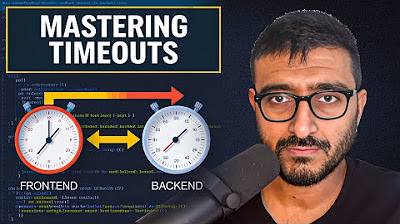How to safely and gracefully handle timeouts in a microservices
Summary
TLDRThis video discusses strategies for effectively handling timeouts in microservices architectures. It emphasizes the importance of setting timeouts for synchronous communication, carefully choosing the right timeout values to avoid false positives and performance bottlenecks, and leveraging retries with proper backoff mechanisms. The speaker also advocates for asynchronous communication and event-driven architectures to reduce synchronous dependencies between services. Key best practices include ensuring idempotency for retries and considering re-architecting services for improved scalability and resilience. The video is a practical guide to managing service communication and ensuring smooth operations in complex microservices environments.
Takeaways
- 😀 Always have timeouts in place when performing synchronous communication with any microservice to avoid indefinite waiting.
- 😀 ⏱️ Picking the right timeout value is critical—too short and you'll face false positives, too long and it could result in performance bottlenecks.
- 😀 🔄 Make retries safe by designing services with idempotency in mind. This prevents unintended side effects during retries.
- 😀 💡 Event-driven architecture can help reduce synchronous dependencies between services, leading to more scalable and independent systems.
- 😀 🔄 A good retry strategy uses exponential backoff to prevent overloading the system during retries, especially when services are under heavy load.
- 😀 🛑 Remove unnecessary synchronous dependencies by duplicating or ingesting data directly into the service, making it more autonomous.
- 😀 ⏳ When setting timeouts, ensure that the timeout value reflects the typical response times of the dependent services for better performance.
- 😀 ⚙️ Services should be designed with fault tolerance in mind, such as having fallback mechanisms for when data is unavailable due to a timeout.
- 😀 🚀 A microservice-based architecture should prioritize reducing the complexity of inter-service dependencies, making each service as independent as possible.
- 😀 🧠 Re-architecting a solution to support asynchronous or event-driven communication can be an effective long-term strategy to avoid timeouts.
- 😀 🏗️ Even when facing potential timeouts or failures, ensuring that each microservice is robust and resilient ensures better user experience and system stability.
Q & A
Why is handling timeouts important in microservices?
-Handling timeouts is crucial in microservices to prevent services from waiting indefinitely for a response. It ensures system stability and prevents resource exhaustion due to stalled requests.
What are the common problems when microservices communicate with each other?
-Common problems include requests never reaching the service due to network issues, responses not arriving due to connection problems, or services taking too long to respond because of overloads or resource bottlenecks.
What are some approaches to handle timeouts in a microservices architecture?
-Some approaches include ignoring the timeout and proceeding with default values, using retries with exponential backoff, or re-architecting the system to handle asynchronous or event-driven communication.
Why should retries be handled cautiously in microservices?
-Retries should be handled cautiously because they can lead to issues like unnecessary load or incorrect outcomes if the operation is not idempotent. Ensuring that retries do not cause negative side effects is essential.
What is exponential backoff, and why is it important for retries?
-Exponential backoff is a technique where the wait time between retries increases exponentially. This prevents overwhelming the system with frequent retry attempts and helps in reducing the load during failures.
What does it mean for a system to be idempotent, and why is it important for retries?
-An idempotent system allows an operation to be repeated multiple times with the same result. This is important for retries because it ensures that performing the same operation multiple times doesn't cause unintended side effects or inconsistent states.
What is an event-driven architecture, and how can it help reduce synchronous dependencies in microservices?
-An event-driven architecture allows services to communicate through events rather than direct synchronous calls. This reduces the need for services to wait for responses and can improve overall system performance and resilience.
What are the risks of setting timeout values that are too short or too long?
-Timeout values that are too short can result in false positives, where services timeout prematurely despite being able to respond. Timeout values that are too long can lead to performance bottlenecks as services wait for responses longer than necessary, impacting system throughput.
How can you ensure safe retries in a microservices environment?
-Safe retries can be ensured by making operations idempotent, meaning they can be retried without adverse effects. Additionally, implementing retry mechanisms with controlled backoff strategies can prevent overloading services.
What is the recommended approach if synchronous communication creates bottlenecks in your microservices architecture?
-If synchronous communication creates bottlenecks, it's recommended to consider re-architecting the system to use asynchronous or event-driven communication, where services can operate independently without relying on immediate responses.
Outlines

This section is available to paid users only. Please upgrade to access this part.
Upgrade NowMindmap

This section is available to paid users only. Please upgrade to access this part.
Upgrade NowKeywords

This section is available to paid users only. Please upgrade to access this part.
Upgrade NowHighlights

This section is available to paid users only. Please upgrade to access this part.
Upgrade NowTranscripts

This section is available to paid users only. Please upgrade to access this part.
Upgrade NowBrowse More Related Video

10 Challenges in Adopting and Implementing Microservices

Frontend and Backends Timeouts

Microservices Explained in 5 Minutes

Advantages of adopting a microservices-based architecture

Introduction to System Design - MVC and Three-Tier Architecture

Capgemini Java Interview 2024 | Java | Spring Boot | Microservices | Database
5.0 / 5 (0 votes)